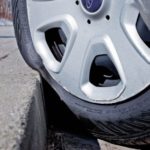How to properly wash your car?
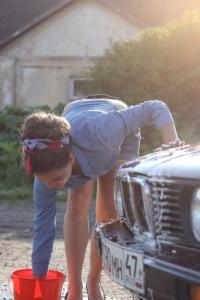
How to properly wash your car?
There is not only one way to wash a car properly, but there are many wrong ones, where you can easily scratch the paint or destroy its shine. The most important thing is to prevent the dirt you want to remove from turning into sandpaper, which will cause damage to the varnish.
Not in the bright sun
Before you start washing, find a suitable place. Under no circumstances should the car be exposed to direct sunlight, due to the rapid drying of the foam / shampoo, water and other means you may use. If you can't find such a place, then wash it in the early morning or in the evening. Also, the car itself must not be hot.
Which shampoo to use?
Never use aggressive detergents used in the kitchen or bathroom, as varnish or plastic and rubber parts can easily be damaged. For example, Cif, Wim or Arf wash well, degrease and remove everything and anything, but they also have abrasive properties, ie. they have tiny particles in them that will scratch the paint of your car.
Ordinary dishwashing detergent is not recommended either. Maybe it "protects your hands and makes them soft" and maybe many drivers have been using it for years and decades without any problems, but it simply has such chemical properties that do not suit the car's lightness.
So use special shampoos that are intended for car washing. And they have serious differences between the cheapest and the most expensive. The more expensive ones usually have wax in them, so after washing, a thin protective layer remains, which means that the next wash will be easier, ie the dirt will be easier to remove.
Improper washing will ruin your car's glow
When washing a car, two items should be "reconciled" - thoroughly and quickly remove all impurities, without damaging the paint. The main problem is that the impurities contain small particles that under certain conditions can turn into real sandpaper.
Even if you rub very gently and carefully with a sponge, so that no visible scratches remain, improper washing causes micro-damages that gradually make the surface of the varnish rougher and less shiny. We can compare this to sanding with very fine sandpaper.
How to prevent this?
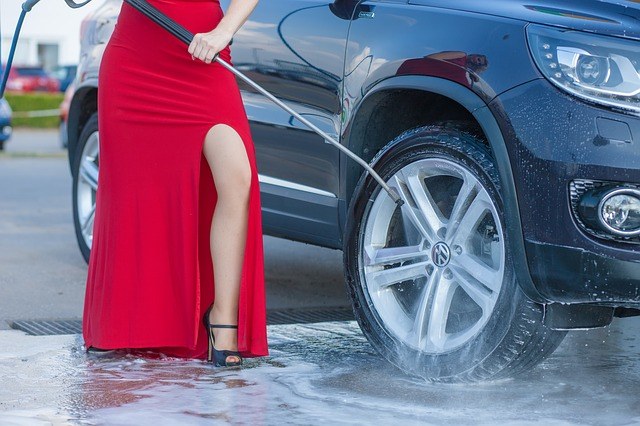
There are several ways to prevent this or at least mitigate the consequences. First of all, you should spray the car well with water before washing, in order to remove as much dirt as possible, and what remains to get wet and make it easier to remove. And you should be careful if you "push" the car in a self-service laundry or somewhere else - for example. you have your own compressor washer (decent can be bought for 70-80 euros).
The pressure of the water must be strong enough to remove impurity, but it must not be too strong and narrow to one point, since in this case sharp beads under water pressure may cause damage.
A sponge or a brush?
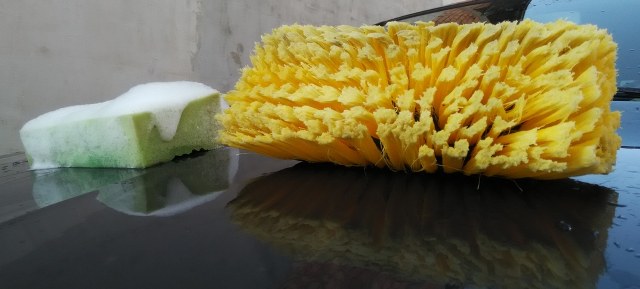
So who else washes a car with a brush ?! Answer: those who think that after you have removed only larger particles by spraying with a hose, that there are many smaller ones left, so when you start rubbing with a sponge, it will "catch" them and you will scratch the varnish. How many scratches there will be depends on the size and shape / sharpness of the particles. If you wash gently and before that you have thoroughly washed the dirt with a hose, you may never notice any scratches, but because of that, the paint of your car will quickly lose its shine, that is. matte.
Others claim that the brush is the one that scratches, since the sponge actually receives dirt in its pores (openings of various sizes), so there is no talk of it turning into sandpaper, while the brush practically rolls dirt on the varnish.
So, there is a bitter fight here, but the sponge is still in a convincing lead - almost all professionals in this field use it, and it is up to each driver to decide what to use to wash his car.
Not all brushes are the same
If you buy a cheap and low-quality brush, with rigid bristles, grouped in "tufts", washing with such a brush will not be quick or efficient, regardless of whether it has a system for passing water through itself, ie a hose connection. At the same time, the ends of the fibers will probably be sharply cut, so they can scratch the varnish.
The brush should have softer bristles, thicker and evenly distributed. The ends of the fibers themselves should be "bloomed" or the fibers should be made in such a way or from a natural material so that they do not have sharp ends.
So it pays to give a little more money and buy a better quality brush, which can usually be mounted on a telescopic handle, which greatly facilitates washing the roof and lower parts of the car.
Believe us, when you first try a telescopic brush and realize that you don't have to bend or squat while washing the lower body parts, you will realize that every penny is worth it.
In case you decide to use a brush, be sure to take one that can be mounted on the water hose so that you can wash the car at the same time while the water comes out of the brush and washes away dirt. Keep in mind that many drivers have negative experiences with brushes like this, as not all brushes are the same. Some simply do not have a good system for leaking water through the bristles of the brush, so washing is inefficient and drivers give up on them.
Let's get back to the sponge
Not all sponges are the same. In general, it pays to buy a better quality sponge. Also, it is not easy to remove microscopic grains of sand and other hard impurities from the sponge, so you should not save on buying a new sponge from time to time. Namely, even if you do not feel any grains or any traces of dirt under your fingers, they may be in the deeper layers of the sponge, so they may come into contact with the varnish during the next wash when you press the sponge.
There are also special microfiber gloves that look like they are made of "dreadlocks"… They look like in the picture below:
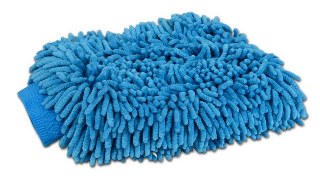
And now - washing!
Here we are talking only about washing with a sponge:
1) Prepare all necessary materials / equipment. If it’s cold, rubber boots are a big help. Two (2) buckets, shampoo, sponge, special rim sponge…
2) If you have a lot of flattened and dried / baked flies on the front end, it would not be bad to first spray that part with water, then apply a fly remover, let it work for a while and then rinse. After that, the flies will be much easier to remove. Attention! These products must not be left to act or dry for too long, as they can act aggressively on the varnish.
3) Wash the wheels first - if you wash the whole car, and only then get to the wheels, a lot of dirt from them will end up on the surrounding parts of the sheet metal and bumpers. So process them first, then move on to the rest. More about washing wheels below.
4) Spray the entire car with water to remove as much dirt as possible. Start washing. Use two buckets. In the first, mix the shampoo with water and make a lot of foam. You will dip a sponge into it and wash the car. Pour only clean water into the other bucket - you will only rinse the sponge in it. So, sponge in a bucket of foam, washing the car, rinsing in a bucket of clean water, then in a bucket of foam, then washing again…
True, the water in that clean water bin will not stay clean for long, but nothing prevents you from replacing the dirty water occasionally with clean water.
5) Wash the car from top to bottom. First the roof, the glass, then the sides.
6) Divide the body surface into two or four parts and wash one by one. Wash one part, rinse it with water, then move on to the next. That way, the shampoo will not dry on the sheet and leave traces.
7) It is also recommended to use two sponges - one for the upper, usually cleaner parts, and the other for the lower, dirtier parts of the body.
8) Don't forget to wash the sills and other hidden parts.
9) After washing, the car should be wiped so that no traces of water remain. It is best to use microfiber cloths (so-called magic). Soak it in water, drain it well and then gently collect the water from the cart. As soon as it is soaked in water, drain it. Deerskin can also do the job and many use it, but a microfiber cloth is still better. Wipe from top to bottom, just like you washed. Many drivers hate this part of the job the most: it will drain, dry out, who else wipes the car… However, this step is also very important in order for the varnish to preserve its shine.
10) Open the door and wipe the sills and other parts where water has been found.
How to wash the wheels?
Many, even in car washes, use dilute hydrochloric acid to remove stuck dirt and grease faster. It should be borne in mind that hydrochloric acid is very aggressive and can damage the paint / paint on aluminum wheels.
Therefore, special alloy wheel cleaners should be used:
a) Wheels first spray well with water and wash with shampoo to remove as much dirt as possible
b) Spray a special alloy wheel cleaner. Be sure to read the instructions for use (!!!) - some products are left to act for only 15 or 30 seconds, others for one minute, and the third for up to five minutes.
c) After the time allotted for the action of the product has passed, you can only wash the rims, and if the dirt has stuck harder, you can also use a special brush, cloth or sponge. In this case, you do not have to strictly follow the instructions for use, because rinsing alone will often not be enough to remove all the dirt. Namely, with some means, only rinsing is mentioned.
d) Never use cleaning agents in strong sunlight or if the wheels are hot.
When it comes to steel wheels, the same means can be used. You can remove the wheel covers as this will make them easier to wash, unless you are afraid that you will damage them by frequent removal / installation or you have fastened them with plastic ties, so you do not want to cut them.
How to get resin and bird droppings from your car?
The resin, plant sap of trees and the secretions of various insects and birds that live in the branches can do serious damage to the paintwork of your car. It is extremely important that you start removing dangerous impurities as soon as possible, so that they are not allowed to start a chemical reaction with the varnish. The longer you wait, the greater the chance that permanent damage will occur.
How to remove the resin? First wash the car with shampoo to spot where the resin has stuck. It is advisable to use hot water. The most effective are special means intended for resin removal, and you can find them in car cosmetics stores. It is necessary to spray the places with resin and wipe with a cloth. Read the instructions for use carefully, in order for the product to work as efficiently as possible.
If you are not able to buy a special resin remover immediately, there are various handy tools with different efficiencies.
- medical alcohol. Soak cotton wool in alcohol, put on resin, leave for a few minutes and wash
- oil thinner. Soak a cotton ball and remove the resin with gentle movements. Be careful not to damage the varnish
- lock de-icing agent. Put a few drops on the resin, wait a few minutes and wipe
- margarine / butter. It seems strange, but it can help. Spread a thick layer, leave it to act longer and wash
- edible oil. The oil dissolves the resin, but it takes a long time. Therefore, soak the place with resin with oil with the help of cotton wool or a cloth and leave it overnight. Wipe and wash in the morning. Baby oil or sunscreen will also be used
The effectiveness of each of these products depends on many factors, such as the temperature of the air and the surface of the car itself, the type of dirt, the length of standing… Never use nitro thinner, brake cleaners or brake oil.
You completely removed the resin, vegetable juice, honey dew or bird droppings, but stains remained on the varnish. What to do? It depends on the case. Sometimes washing again or using professional means will help, but often it will not.
Then the only solution is polishing. If polishing does not help, which can happen if the dirt has been in contact with the varnish for a long time, more serious (and more expensive) intervention is necessary.
Bird droppings the most dangerous! Remove bird droppings immediately! Don't wait to get home or to the gas station. If you don't have a bottle of water in your car, stop by the first store, buy water and wipes, and remove the feces.
Conclusion
The paintwork of your car will matte over time and get smaller or larger scratches no matter how much you take care of it. Washing, sun, salt, parking, resin and sap from trees, bird droppings… What you can do to slow down this process is careful washing with appropriate means, quality waxing, occasional polishing (professional) and the like.
It all depends on how much you care about the car shining as a decoration on the Christmas tree and how much money / effort / time you are willing to invest.
Prepared by: Dragan Romčević
Retrieved from: www.polovniautomobili.com
Recommendation of similar texts:

Hi there, I am Mladen and I am an auto enthusiast. I started this blog years ago to help like minded people share information about latest cars, car servicing ideas, used car info, exotic cars, and auto technology. You will find helpful articles and videos on a wide variety of cars - Audi, Mercedes, Toyota, Porsche, Volvo, BMW and much more. Ping us if you have anything cool to share on latest cars or on how to make older cars more efficient, or just want to say hi!





